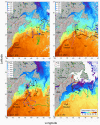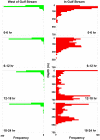Migration pathways, behavioural thermoregulation and overwintering grounds of blue sharks in the Northwest Atlantic - PubMed (original) (raw)
Migration pathways, behavioural thermoregulation and overwintering grounds of blue sharks in the Northwest Atlantic
Steven E Campana et al. PLoS One. 2011.
Abstract
The blue shark Prionace glauca is the most abundant large pelagic shark in the Atlantic Ocean. Although recaptures of tagged sharks have shown that the species is highly migratory, migration pathways towards the overwintering grounds remain poorly understood. We used archival satellite pop-up tags to track 23 blue sharks over a mean period of 88 days as they departed the coastal waters of North America in the autumn. Within 1-2 days of entering the Gulf Stream (median date of 21 Oct), all sharks initiated a striking diel vertical migration, taking them from a mean nighttime depth of 74 m to a mean depth of 412 m during the day as they appeared to pursue vertically migrating squid and fish prey. Although functionally blind at depth, calculations suggest that there would be a ~2.5-fold thermoregulatory advantage to swimming and feeding in the markedly cooler deep waters, even if there was any reduced foraging success associated with the extreme depth. Noting that the Gulf Stream current speeds are reduced at depth, we used a detailed circulation model of the North Atlantic to examine the influence of the diving behaviour on the advection experienced by the sharks. However, there was no indication that the shark diving resulted in a significant modification of their net migratory pathway. The relative abundance of deep-diving sharks, swordfish, and sperm whales in the Gulf Stream and adjacent waters suggests that it may serve as a key winter feeding ground for large pelagic predators in the North Atlantic.
Conflict of interest statement
Competing Interests: The authors have declared that no competing interests exist.
Figures
Figure 1. Blue shark PAT tag and pop-up locations.
Map shows tagging (∗) and pop-up (•) locations for 23 blue sharks tagged off the eastern coast of Canada. Pop-up symbols are coloured to match the corresponding tagging symbol. Month of pop-up indicated by number.
Figure 2. Blue shark migration pathways by year.
Reconstructed migration pathways (one colour-coded solid line per shark) of blue sharks tagged with PATs, overlaid on the SST satellite imagery on the date corresponding to their presence. Sharks not entering the Gulf Stream within 2 weeks of the date corresponding to the satellite imagery are not shown. Imagery date is shown in the lower left corner of each panel, and tag pop-up month is indicated at the end of each track. Tracks of tags 56390 and 56395 (2005), 66390 and 66391 (2006), and 34517 (2007) have been truncated by 0–2 degrees at the eastern edge of the SST imagery.
Figure 3. Maximum daily depth of blue sharks across months.
Maximum depths varied with the month, but were much greater after entry into warm Gulf Stream waters (red) than prior to entry (green). Symbols show mean ± 1 SE.
Figure 4. Mean depth and temperature of blue sharks across months.
Symbols show mean ± 1 SE depth (A) and temperature (B) while in (red) or out of (green) warm Gulf Stream waters.
Figure 5. Frequency distribution of depths occupied by blue sharks by time of day.
Panels show depth frequencies by 6-hr interval while in (red) or out of (green) warm Gulf Stream waters. Sharks only show extensive diel vertical migration while in the Gulf Stream, and tend to be deepest during daylight hours.
Figure 6. Diel changes in vertical distribution of blue sharks.
Mean ±95% CI depth (A) and temperature (B) of blue sharks by 6-hr interval while in (red) or out of (green) warm Gulf Stream waters. Sharks only show extensive diel vertical migration while in Gulf Stream.
Figure 7. Examples of blue shark dive profiles overlaid on the temperature field.
Time-weighted depths of individual blue sharks (solid black lines) from 2006 (left panels) and 2007 (right panels) at 6-hr intervals, overlaid on the colour-coded water temperature field as recorded by the PAT. Note the initiation of daily deep diving behaviour shortly after encountering the warm surface waters of the Gulf Stream.
Figure 8. Blue shark depth at midnight versus phase of the moon.
Sharks in the Gulf Stream moved to significantly greater depths as the moon became fuller. A loess curve has been fit to the data.
Figure 9. Net influence of diel diving behaviour on blue shark displacements.
Ocean currents averaged over 4 years at depths of 35 m (A, thin vectors) and 600 m (B). The longest vector corresponds to a speed of 45 cm/s. Displacement vectors associated with the diving behavior are shown at the pop-up locations as bold vectors in A. Note that these displacement vectors are averaged over the full lifetime of the PATs and are normalized to give the change in displacement over a 200 day period. The inset in B shows the zonal velocities through the section indicated by the bold dashed line; solid contours indicate eastward flow while the dashed contour line indicates westward flow.
Similar articles
- Biogeophysical and physiological processes drive movement patterns in a marine predator.
Howey LA, Wetherbee BM, Tolentino ER, Shivji MS. Howey LA, et al. Mov Ecol. 2017 Jul 18;5:16. doi: 10.1186/s40462-017-0107-z. eCollection 2017. Mov Ecol. 2017. PMID: 28725435 Free PMC article. - White shark offshore habitat: a behavioral and environmental characterization of the eastern Pacific shared offshore foraging area.
Nasby-Lucas N, Dewar H, Lam CH, Goldman KJ, Domeier ML. Nasby-Lucas N, et al. PLoS One. 2009 Dec 9;4(12):e8163. doi: 10.1371/journal.pone.0008163. PLoS One. 2009. PMID: 20011032 Free PMC article. - Shark predation on migrating adult American eels (Anguilla rostrata) in the Gulf of St. Lawrence.
Béguer-Pon M, Benchetrit J, Castonguay M, Aarestrup K, Campana SE, Stokesbury MJ, Dodson JJ. Béguer-Pon M, et al. PLoS One. 2012;7(10):e46830. doi: 10.1371/journal.pone.0046830. Epub 2012 Oct 17. PLoS One. 2012. PMID: 23082131 Free PMC article. - Diet Composition and Trophic Ecology of Northeast Pacific Ocean Sharks.
Bizzarro JJ, Carlisle AB, Smith WD, Cortés E. Bizzarro JJ, et al. Adv Mar Biol. 2017;77:111-148. doi: 10.1016/bs.amb.2017.06.001. Epub 2017 Aug 18. Adv Mar Biol. 2017. PMID: 28882212 Review. - The biology and ecology of the basking shark: A review.
Gore M, Camplisson E, Ormond R. Gore M, et al. Adv Mar Biol. 2023;95:113-257. doi: 10.1016/bs.amb.2023.08.005. Epub 2023 Oct 28. Adv Mar Biol. 2023. PMID: 37923538 Review.
Cited by
- Vertical movement patterns and ontogenetic niche expansion in the tiger shark, Galeocerdo cuvier.
Afonso AS, Hazin FH. Afonso AS, et al. PLoS One. 2015 Jan 28;10(1):e0116720. doi: 10.1371/journal.pone.0116720. eCollection 2015. PLoS One. 2015. PMID: 25629732 Free PMC article. - Tracking Anguilla japonica Silver Eels Along the West Marina Ridge Using Pop-up Archival Transmitting Tags.
Higuchi T, Watanabe S, Manabe R, Kaku T, Okamura A, Yamada Y, Miller MJ, Tsukamoto K. Higuchi T, et al. Zool Stud. 2018 Jun 4;57:e24. doi: 10.6620/ZS.2018.57-24. eCollection 2018. Zool Stud. 2018. PMID: 31966264 Free PMC article. - Evidence for behavioural thermoregulation by the world's largest fish.
Thums M, Meekan M, Stevens J, Wilson S, Polovina J. Thums M, et al. J R Soc Interface. 2013 Jan 6;10(78):20120477. doi: 10.1098/rsif.2012.0477. Epub 2012 Nov 8. J R Soc Interface. 2013. PMID: 23075547 Free PMC article. - Behavioural flexibility in an Arctic seabird using two distinct marine habitats to survive the energetic constraints of winter.
Patterson A, Gilchrist HG, Robertson GJ, Hedd A, Fifield DA, Elliott KH. Patterson A, et al. Mov Ecol. 2022 Nov 3;10(1):45. doi: 10.1186/s40462-022-00344-3. Mov Ecol. 2022. PMID: 36329536 Free PMC article. - Mesoscale eddies release pelagic sharks from thermal constraints to foraging in the ocean twilight zone.
Braun CD, Gaube P, Sinclair-Taylor TH, Skomal GB, Thorrold SR. Braun CD, et al. Proc Natl Acad Sci U S A. 2019 Aug 27;116(35):17187-17192. doi: 10.1073/pnas.1903067116. Epub 2019 Aug 6. Proc Natl Acad Sci U S A. 2019. PMID: 31387979 Free PMC article.
References
- Walker TI. Can shark resources be harvested sustainably? A question revisited with a review of shark fisheries. Mar Freshwater Res. 1998;49:553–572.
- Stevens JD, Bonfil R, Dulvy NK, Walker PA. The effects of fishing on sharks, rays and chimaeras (chondrichthyans), and the implications for marine ecosystems. ICES J Mar Sci. 2000;57:476–494.
- International Commission for the Conservation of Atlantic Tunas. Report of the 2008 shark stock assessments meeting. ICCAT SCRS/2008/017 2008
- Mandelman JW, Cooper PW, Werner TB, Lageux KM. Shark bycatch and depredation in the U.S. Atlantic pelagic longline fishery. Rev Fish Biol Fisheries. 2008;18:427–442.
- Mejuto J, Garcia-Cortés B, Ramos-Cartelle A, de la Serna JM. Scientific estimations of bycatch landed by the Spanish surface longline fleet targeting swordfish (Xiphias gladius) in the Atlantic Ocean with special reference to the years 2005 and 2006. ICCAT SCRS Doc. 2008/045 2008
Publication types
MeSH terms
LinkOut - more resources
Full Text Sources








